The Harvest Moon appears from September 9 to 11! The Moon will appear full for about three days around this time, from Friday through Sunday. Why does this phenomenon happen? Learn more—and shine on, Harvest Moon!
Advertisement
When Is the Harvest Moon?
This year, the brilliant Harvest Moon first appears in the evening of Friday, September 9, before reaching peak illumination at 5:58 A.M. EDT on Saturday, September 10 (it will be below the horizon at this time, however).
One thing that sets the Harvest Moon apart from other full Moon names is that it’s not associated with a specific month, as the others are. Instead, the Harvest Moon relates to the timing of the autumnal equinox (September 22, 2022), with the full Moon that occurs nearest to the equinox being the one to take on the name “Harvest Moon.” This means that the Harvest Moon can occur in either September or October, depending on how the lunar cycle lines up with the Gregorian calendar.
The Harvest Moon does typically occur in September, taking the place of the full Corn Moon. However, it occasionally lands in October instead, replacing the full Hunter’s Moon.
Why Is it Called the Harvest Moon?
For several evenings, the moonrise comes soon after sunset. This results in an abundance of bright moonlight early in the evening, which was a traditional aide to farmers and crews harvesting their summer-grown crops. Hence, it’s called the “Harvest” Moon!
There are just a little over 12 complete Moon cycles every year, on average (there being about 29.53 days in a synodic month). The Harvest Moon isn’t like the other Moons.
- Usually, throughout the year, the Moon rises an average of about 50 minutes later each day.
- But for the few nights around the Harvest Moon, the Moon seems to rise at nearly the same time: just 25 to 30 minutes later across the northern USA, and only 10 to 20 minutes later farther north in Canada and Europe.
Additionally, the Harvest Moon rises at sunset and then will rise very near sunset for several nights in a row because the difference is at a yearly minimum. It may almost seem as if there are full Moons multiple nights in a row!

More About the Harvest Moon
If interested, here is more detailed information about the Harvest Moon. (Warning: Scientific explanation below!)
The Moon’s orbital motion (combined with the larger orbit of the Earth around the Sun) carries it farther eastward among the constellations of the zodiac from night to night. At any one moonrise, the Moon occupies a particular place on the celestial sphere (the great dome of the heavens), but when the Earth turns toward that point 24 hours later, the Moon has moved off to the east about 12 degrees, and it takes an average of 50 minutes longer for the Earth to rotate toward the Moon and for the Moon thus to “rise.” Think of it as a giant Slinky in which each loop, representing one lunar orbit of the Earth, advances the orbit a bit farther along the spiral path. The result of all this is that the Moon doesn’t rise at the same time everyday.
But around the date of the Harvest Moon, the Moon does rise at about the same time for several days in a row. Why? Remember that the zodiac is the band of constellations through which the Moon travels from night to night. The section of the zodiac band in which the full Moon travels around the start of autumn is the section that forms the most shallow angle with the eastern horizon. Because the Moon’s orbit on successive nights is more nearly parallel to the horizon at that time, its relationship to the eastern horizon does not change appreciably, and the Earth does not have to turn as far to bring up the Moon.
The Moon may rise as little as 23 minutes later on several nights before and after the full Harvest Moon (at about 42 degrees north latitude), which means extra light at peak harvest time near autumn. By the time the Moon has reached last quarter, however, the typical 50-minute delay has returned.
At the start of spring, the opposite applies. The full Moon is in the section of the zodiac that has the steepest angle with respect to the eastern horizon. For several days bracketing the full Moon nearest the vernal equinox, the delay in moonrise is as much as 75 minutes (at 42 degrees north latitude).

Here is another way of expressing what happens with the Harvest Moon: It is in this part of the zodiac that the Moon’s eastward (orbital) motion has its largest northward component. For observers in Earth’s Northern Hemisphere, the farther north an object is in the heavens, the longer an arc it makes across the sky, and the longer a time it is visible above the horizon. Thus, to say that the Moon is getting rapidly farther north each night around the time of the Harvest Moon is to say that, for northern latitudes on Earth, it will keep rising distinctly earlier than would otherwise be expected—nearly the same time as the night before.
How nearly the same is “almost the same time” each night? This varies with latitude, for the farther north you are, the shallower the angle of the zodiac is with respect to your horizon. In most of the United States and southern Canada, the Harvest Moon rises 25 to 30 minutes later each night. The effect is less noticeable the farther south you go. But going north makes the Harvest Moon more extreme.
According to astronomy author Guy Ottewell, the idea of the Harvest Moon originated in Europe (average latitude about 50 degrees north), where the Harvest Moon rises only ten to 20 minutes later each night. It must have seemed a boon that just when days were getting rapidly shorter and the Sun seemed to go down all too soon, the Harvest Moon arrived to extend the hours that harvesting could be done.

Chinese Harvest Moon Traditions
As a final note, I should add that it is not just Western civilization that has given special importance to the Harvest Moon. For Chinese people everywhere, this full Moon is the occasion for the Festival of the August Moon (the “August” is through a calendar discrepancy) or Mid-Autumn Festival (in some cultures, the equinoxes and solstices have been considered the middle of the seasons). This festival is celebrated with joyful games and the eating of “Mooncakes.”
I remember vividly being invited to one such celebration and singing songs and playing my guitar to a circle of friendly faces in the light of the rising Harvest Moon.
Learn More
Ever notice that the low-hanging Moon looks especially big near the horizon? It isn’t really significantly bigger. Learn more about this trick of the eye called the Moon Illusion.
Find out what your Moon phase is tonight and when the next full Moon is.













Comments